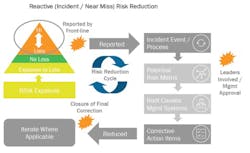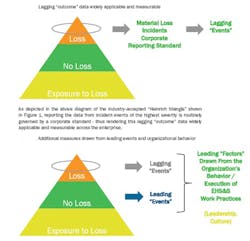Optimizing Safety Through Leading Indicators
In the past, the most common way to measure the safety performance of a business was to look at “lagging” indicators. The number of incidents and injuries would be metrics tasked with painting a comprehensive picture of the EHS performance of an organization, even if they entirely were based on historic data. Lagging indicators are easy to measure, but typically offer insight into the outcome of a process only after an incident has taken place. That means they’re rather tricky to influence.
Let’s think about our oldest of EHS friends: the numbers of incidents and injuries. They’re useful, sure, but only to measure safety performance to date. Thus, they’re of extremely limited use when attempting to improve future performance and prevent further incidents from taking place.
Leading indicators can provide actionable EHS information that can help reduce risk and encourage teams to be more proactive in preventing incidents. You therefore can think of a leading indicator as a form of predictive analysis. Predictive data can go one step further than the “what” and “why” of an incident by giving an indication as to what might happen next.
Research Into Leading Indicators
We recently worked with several companies on a leading indicator initiative. Each of these companies is applying a common approach to collect and analyze data from myriad risk-reduction activities such as incident investigations, near-miss reports, management system audits, risk assessments, assurance reviews, behavioral observations, field-level inspection programs, hazard analysis and many other processes. A recent analysis of a data set spanning 14 companies showed an average of 58 sources of data totaling millions of records over several years.
On the surface, each of these organizations simply have been using a common “mechanism” to manage their own unique set of environmental, health, safety and sustainability risk-reduction processes and ultimately analyze the resulting data, i.e., the “outcome” (EHSS) data. However, at a deeper level, these companies not only are collecting data resulting from the outcomes (e.g., incident reports, injury details, spill quantities, near-miss types, root causes, audit results, assessment scores, inspection findings, etc.) but also the work practice behaviors reflecting the organization’s tendencies in executing such processes, such as the mean times between completion of critical process steps, rate of leadership involvement in nonmandatory proactive steps, distribution of employee involvement in proactive activities and more.
With such a vast data set from both the outcomes and the work practice behaviors, these companies created a unique opportunity not only for themselves but also for anyone in the industry who is interested in finding the real leading indicators of performance – those activities, practices, factors, conditions, etc. – that are practically measurable and are proven to have a mathematical relationship to loss outcomes.[DD1]
Drawing Leading Data from Lagging Events
It has become common to find companies that have implemented an enterprise-wide incident database to collect data resulting from the outcomes of incidents. However, some companies also are executing corporate-wide incident management process improvement projects along with an information system that not only collects incident data, but also enables/facilitates each major step of the business process.
As depicted in Figure 1 below, applying a risk-reduction solution for managing incident/near-miss events enables the full event life cycle – from front-line worker reporting events to leadership involvement and the remediation of action items – of the business process.
By comprehensively facilitating the entire risk-reduction cycle business process, the various levels of the workforce simply are carrying out the routine incident/near-miss work practice using a business process automation (BPA) tool. However, the byproduct of facilitating each major step of all near-misses and incident events on an integrated software platform is the ability to practically draw measurements from both the incident/near-miss event outcome data and the data reflecting the workers’ interaction with each step of those business processes.
By analyzing the business process data to study the organizational treatment of these lagging events, leading metrics such as the percentage of the workforce involved in near-miss reporting, the ratio of near-miss to high-consequence reports, the rate of leadership participating in nonmandatory events, consistency of manager response to key steps, and many other potential Leading Indicators of culture and leadership can be created.
Through this automation of lagging incident/near-miss business processes, the data for calculating both lagging outcome metrics and leading indicators is efficiently generated. The companies executing in this manner are achieving the ironic accomplishment of drawing leading data values from the occurrence of lagging incident/near-miss events.
Figure 2 and Figure 3
Integrating Key Work Steps
Most companies deploy a vast array of different proactive business processes that fit the risk-reduction cycle pattern, ranging from formal corporate-level auditing processes to more casual field-level suggestion box/hazard ID type initiatives. Typically, the data resulting from the outcomes of such proactive activities is scattered throughout the organization on pieces of paper, spreadsheets, isolated databases and other nonintegrated systems, rendering broad measurements highly impractical.
An enterprise-wide risk-reduction solution enables the integration of the key work practice steps and data elements across a wide array of different proactive processes.
Per the previously mentioned average of 58 sources of activities fitting this pattern, [DD2] roughly 90 percent of those activities are proactive, assessment-based activities. By facilitating a wide array of processes on a common BPA tool, the data from both the outcomes of the activities and the work-practice behaviors is available for trending across previously segregated processes.
With this approach, common measurements can be drawn from processes, which are routinely viewed as dissimilar. For example, the rate of employee participation per a behavioral-based safety (BBS) process can be combined with the rate of participation in other dissimilar processes such as risk assessments, hazard ID reports, inspections, self-assessments, walk-through audits and many others to calculate a comprehensive rate of proactive employee involvement, a key measure of reporting culture.
In addition, the final major step for all risk reduction cycle activities entails the process of managing the action items required to install protective controls and ultimately reduce the risk. With efficient access to action item data from so many different processes, the leading indicator metrics that can be drawn from action item execution are broadly applicable and readily measurable as well.
The Key: Buy-in From Operational Management
Gaining the support of top management is in the critical path for leading indicators to capture their fair share of this KPI landscape. In a recent workshop conducted with leaders in environment, health, safety and sustainability (EHSS) from several global operator and service companies in the energy industry, the overwhelming choice as the greatest obstacle to executing leading indicators was the propensity of top leadership to use lagging metrics in annual management performance objectives and in some cases as key components of manager incentive pay programs.
In today’s cost-competitive marketplace, budgets already are tight. Therefore, convincing operational management to allocate the necessary resources for execution of the programs that support a leading indicator initiative is met with resistance rooted in skepticism. If you cannot convincingly demonstrate that investing in such “leading” activities will result in better EHSS performance, they won’t allocate the resources to execute such a program. To overcome this obstacle, the most effective leading indicators must meet the two following criteria:
1. Minimize additional resources required for execution.
2. Provide sufficient proof that executing leading indicators will improve EHSS performance.
Practical, usable, efficiently calculated metrics with a strong value proposition are required to compel top leadership to give leading indicators a prominent place on the KPI score cards of operational management.
The key components of leading indicators, which effectively may rival the practicality and importance of lagging metrics as KPIs to be executed on an enterprise scale are:
- Simple, close connectivity to the outcome/results.
- Objectively and reliably measurable.
- Interpreted by different groups in the same way.
- Broadly applicable across company operations.
- Easily and accurately communicated.
Why do Lagging Metrics Still Dominate?
Many companies are tracking and analyzing leading indicators in isolated areas of their businesses but few are applying leading indicators to rival the age-old incident rate as the primary KPI for judging an operation’s EHSS performance. One reason for this dominance is the practicality of having a near standard in producing a normalized performance metric, which can deliver an apples-to-apples comparison of loss rates across the enterprise.
Whether a company uses a calculation similar to the OSHA standard or prefers the more internationally used denominator of 1 million exposure hours, the two key components of safety loss rate measurement – the number of incidents and the quantity of work hours – are much more broadly applicable and readily measurable, thus rendering this type of lagging indicator a more efficient and practical alternative.
In addition to the convenience of lagging indicators, how many times have you heard: “It hasn’t happened here, so it is not a problem”? Given both this human reactionary tendency and the convenience of lagging metrics, leading indicators have quite a battle ahead if they are to gain equal share of the KPI landscape for operations management.
About the authors: Carrie Young is vice president of Consulting Services at Sphera, and is an expert in providing environmental and safety performance improvement through the development of integrated management systems, analytics, organizational capability, enterprise software and governance. She has been helping companies with business process transformation and insights for over 20 years. Todd Lunsford is director of Process Improvement at Sphera, and serves operational excellence project advisor to Sphera customers, enabling them to make critical decisions using the insights gained from their business process data. Lunsford leads business process and usage assessments to advance operational excellence maturity, drawing upon years of experience leading global deployments of operation risk solutions.


